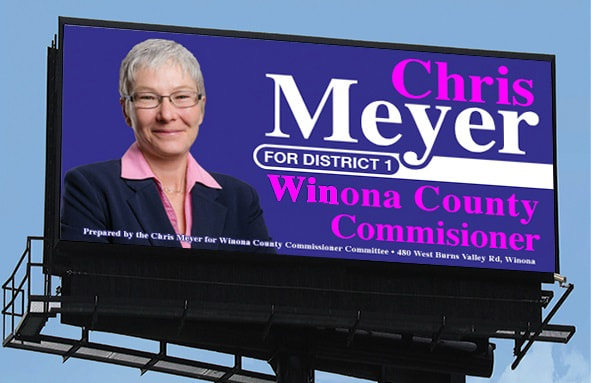|
From the Winona Post - read the full article here Double and Meyer: District One (western Winona)
Former Winona City Council member Paul Double and current Winona County Planning Commission member Chris Meyer are competing to replace retiring county commissioner Jim Pomeroy on the County Board. Meyer called Pomeroy her role model and said, “I think he’s done a fabulous job, and I wouldn’t be running if he were [running].” Meyer added, of her vision for Winona County, “In order for people to live here, we need to be able to make a living, so we need to have a strong economy, and that should be equitably available. But neither of those things are going to be available if we don’t have a planet to live on, and so, clean air, clean water, and healthy soil are critical.” Double called voters’ attention to the $10-million referendum that Winona Area Public Schools will seek this fall, the steady tax increases the city of Winona has adopted, and the tax increases the County Board is considering to balance its budget. “Someone needs to be your voice at the table to say, ‘No,’ with the experience to work through the issues and not only increase property taxes as the only way to solve these problems,” he stated. “I think our county has been missing an opportunity to grow our tax base by not doing more and only focusing on reducing our taxes,” Meyer argued. Growing the tax base could help offset the effect of tax increases. If there were more new businesses and homes in Winona County, existing property owners would have to shoulder a smaller portion of the tax burden. Meyer pointed out that the county once had a full-time economic development coordinator who helped rural cities apply for development grants, helped local businesses attract workers, and strategized on how to make the most of growth from Rochester’s Destination Medical Center (DMC) project. County administrators have since eliminated the position. “To expand our tax base, I think we need to give assistance to our small townships and small municipalities,” Meyer said. There are grant opportunities that could help, but small towns with limited staff do not have the time to pursue them without help from the county, she stated. Housing and transportation are critical to Winona County’s economic growth, Double stated. “Transportation … is the single largest expense for the workforce behind housing. We need to address it … We need to work hard with our industrial-development groups and get them to look at the fact that, as we expand our development in the rural areas and look at housing in the rural areas — if people move for less expensive housing — that transportation issue flourishes [at] even higher levels, and we simply need to address it.” Double continued, saying that the County Board needs to really scrutinize its budget and its programs. “What got better? What didn’t change?” he asked. “And the things that didn’t change maybe need to be addressed and eliminated, because if it didn’t get better and it’s not doing the job, there may be some opportunities to look around, not just in the county, but around the United States — our abutting states — to see who has some creative ideas out there at the county level that’s saving them some money and replicating it.” Meyer talked about a different strategy to save money. She pointed out how rising foster-care costs — most commonly the result of parental drug abuse — have played a significant role in driving up the county’s expenses. She advocated for funding Winona County Drug Court and other programs that combat addiction. “Investing in those kinds of programs has the potential to at least keep those costs in check,” she said. Meyer and Double both identified the county jail as one of the most important issues facing the County Board. The current jail has been sanctioned by the Minnesota Department of Corrections (DOC) for not being up to code, and county staff warn that if the county does nothing, the DOC could shut the current jail down entirely. The county is in the early stages of developing a plan to replace the current jail; building a new facility could cost millions of dollars. Double pointed out that there are various categories of inmates — from maximum-security inmates to low-level juveniles offenders — that have different needs. “The jail is clearly a high issue, and how that’s handled, I think, can be done very cost-effectively,” he stated. Meyer has sat in on several of the county’s jail planning meetings. “The jail advisory committee is doing the right thing,” she stated, praising the group’s work to look at options for lowering the jail population and its plans to develop a set of options for how to replace the jail with cost-benefit analyses. Comments are closed.
|

 RSS Feed
RSS Feed